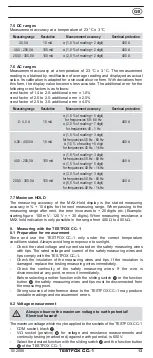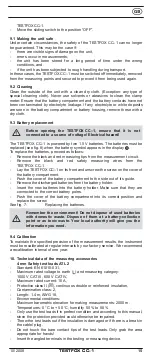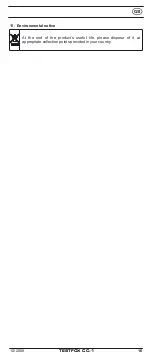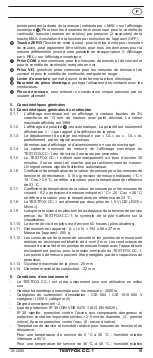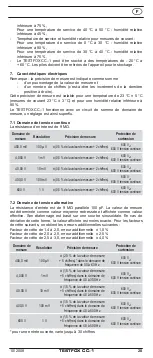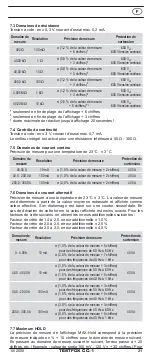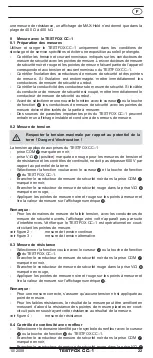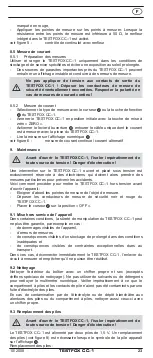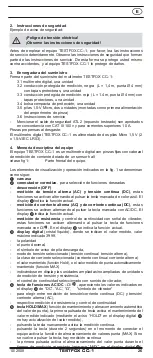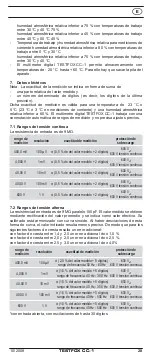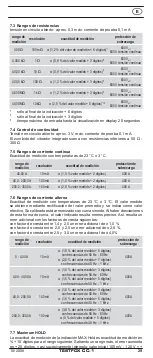
10/ 2008
TESTFOX CC–1
15
TESTFOX CC–1.
- Move the sliding switch to the position “OFF”.
9.1 Making the unit safe
Under certain circumstances, the safety of the TESTFOX CC–1 can no longer
be guaranteed. This may be the case if:
- there are visible signs of damage on the unit,
- errors occur in measurements,
- the unit has been stored for a long period of time under the wrong
conditions, and
- if the unit has been subjected to rough handling during transport.
In these cases, the TESTFOX CC–1 must be switched off immediately, removed
from the measuring points and secured to prevent it from being used again.
9.2 Cleaning
Clean the outside of the unit with a clean dry cloth. (Exception: any type of
special cleaning cloth). Never use solvents or abrasives to clean the clamp
meter. Ensure that the battery compartment and the battery contacts have not
been contaminated by electrolyte leakage. If any electrolyte or white deposits
are seen in the battery compartment or battery housing, remove these with a
dry cloth.
9.3 Battery replacement
Before opening the TESTFOX CC–1, ensure that it is not
connected to a source of voltage! Electrical hazard!
The TESTFOX CC–1 is powered by two 1.5 V batteries. The batteries must be
replaced (see fig. 8) when the battery symbol appears in the display
.
To replace the batteries, proceed as follows:
- Remove the black and red measuring tips from the measurement circuit.
- Remove the black and red safety measuring wires from the
TESTFOX CC–1.
- Lay the TESTFOX CC–1 on its front and unscrew the screw on the cover of
the battery compartment.
- Push the cover of the battery compartment to the side out of its guide.
- Remove the discharged batteries from the battery holder.
- Insert the new batteries into the battery holder. Make sure that they are
connected to the correct battery poles.
- Push the cover of the battery compartment into its correct position and
replace the screw.
See fig. 7:
Replacing the batteries.
Remember the environment! Do not dispose of used batteries
with domestic waste. Dispose of them at a battery-collection
point or as toxic waste. Your local authority will give you the
information you need.
9.4 Calibration
To maintain the specified precision of the measurement results, the instrument
must be recalibrated at regular intervals by our factory service. We recommend
a recalibration interval of one year.
10. Technical data of the measuring accessories
4 mm Safety test leads ATL 2
- Standard: EN 61010-031,
- Maximum rated voltage to earth ( ) and measuring category:
1000 V CAT III, 600 V CAT IV,
- Maximum rated current: 10 A,
- Protective class II (
), continuous double or reinforced insulation,
- Contamination class: 2,
- Length: 1.4 m, AWG 18,
- Environmental conditions:
Maximum barometric elevation for making measurements: 2000 m,
Temperatures: 0 °C to + 50 °C, humidity 50 % to 80 %
- Only use the test leads if in perfect condition and according to this manual,
since the protection provided could otherwise be impaired.
- Throw the test leads out if the insulation is damaged or if there is a break in
the cable/ plug.
- Do not touch the bare contact tips of the test leads. Only grab the area
appropriate for hands!
- Insert the angled terminals in the testing or measuring device.













